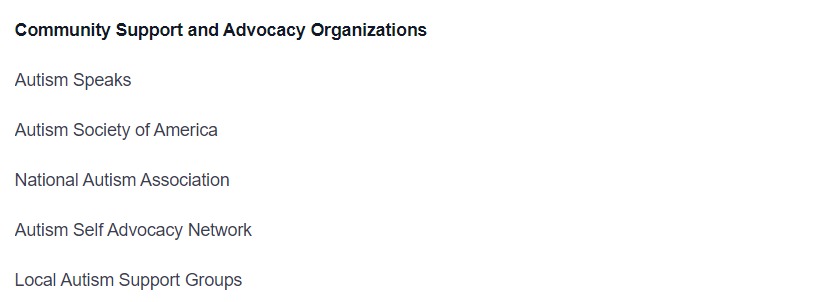Understanding Autism and Physical Safety
Autism is a neurodevelopmental disorder that affects individuals in various ways. It is characterized by differences in social communication, repetitive behaviors, and sensory sensitivities. These unique characteristics can have an impact on the physical safety of individuals with autism.

Exploring the Impact of Autism on Physical Safety
Individuals with autism may face increased challenges when it comes to physical safety. The impact of autism on physical safety can be attributed to several factors:
- Sensory Sensitivities and Impaired Sensory Processing: Many individuals with autism have heightened sensitivities to sensory stimuli, such as loud noises or bright lights. These sensitivities can cause distress and may result in behaviors that compromise physical safety. For example, covering ears to block out noise can make it difficult to hear warning signals or instructions in potentially dangerous situations.
- Difficulty with Social Interactions and Communication: Individuals with autism often experience difficulties in social interactions and communication. This can make it challenging for them to understand and respond to safety instructions, follow rules, or seek help when needed. The inability to effectively communicate or understand social cues can put them at a higher risk of accidents or injury.
- Repetitive and Restricted Behaviors: Engaging in repetitive and restricted behaviors is common among individuals with autism. These behaviors can sometimes involve actions that pose a risk to physical safety, such as repetitive self-harming behaviors or a fixation on dangerous objects. It is important to understand and address these behaviors to minimize the risk of injuries.
By recognizing and understanding the impact of autism on physical safety, appropriate strategies and interventions can be implemented to promote the well-being and safety of individuals with autism. This includes creating a safe environment, providing visual supports, teaching safety skills, and seeking support from healthcare providers, therapists, and community organizations.
Understanding the unique challenges faced by individuals with autism is crucial in ensuring their physical safety and overall well-being. With the right support and resources, individuals with autism can navigate their environment with increased safety and confidence.
Increased Risk Factors
Individuals with autism may face increased risk factors when it comes to physical safety. These risk factors can be attributed to various aspects of autism, such as sensory sensitivities, difficulty with social interactions and communication, and repetitive and restricted behaviors.
Sensory Sensitivities and Impaired Sensory Processing
Autistic individuals often experience sensory sensitivities, which can make them more vulnerable to certain types of injuries. These sensitivities can manifest in different ways, such as being hypersensitive to certain sounds, lights, or textures. As a result, they may have strong reactions or aversions to stimuli that others find tolerable. This heightened sensory response can lead to accidents or injuries when the individual tries to avoid or escape from overwhelming sensory experiences.
Impaired Sensory Processing is also common in autism. This means that individuals may struggle to effectively interpret and respond to sensory information from their environment. They may have difficulty distinguishing between dangerous and non-dangerous situations, making it harder to assess and respond to potential physical risks.
Difficulty with Social Interactions and Communication
Autism often presents challenges in social interactions and communication. Difficulties in understanding social cues, nonverbal communication, and social expectations can impact an individual’s ability to recognize and respond appropriately to potentially dangerous situations. They may struggle to interpret warning signs or signals from others, which can increase their vulnerability to physical harm.
Moreover, limited communication skills can hinder their ability to express their needs or seek help when faced with a safety concern. This can further exacerbate the risk of injury if they are unable to effectively communicate their distress or ask for assistance.
Repetitive and Restricted Behaviors
Repetitive and Restricted Behaviors are common characteristics of autism.
These behaviors can include repetitive movements, rituals, or a fixation on specific objects or topics. Engaging in these behaviors may divert attention away from potential hazards in the environment, making the individual more susceptible to accidents or injuries.
Additionally, certain repetitive behaviors, such as head-banging or self-hitting, can pose a direct risk of self-injury. These behaviors may be a response to sensory overload or a means of self-regulation. Understanding and addressing these behaviors is crucial to minimize the risk of physical harm.
Understanding these increased risk factors associated with autism is essential for promoting the physical safety of individuals on the autism spectrum. By recognizing and addressing these challenges, appropriate support and strategies can be implemented to mitigate the risks and create a safer environment for autistic individuals.
Common Types of Injuries
Individuals with autism may be more susceptible to certain types of injuries due to various factors associated with the condition. Understanding these common types of injuries can help in implementing preventive measures and promoting physical safety for individuals with autism.
Accidental Injuries
Accidental Injuries are one of the most prevalent types of injuries experienced by individuals with autism. Factors such as sensory sensitivities, impaired motor coordination, and difficulties with safety awareness and judgment can contribute to an increased risk of accidents. Some common examples of accidental injuries include falls, bumps, and collisions.
To address accidental injuries, it is essential to create a safe and structured environment that minimizes potential hazards. This may involve removing clutter, securing furniture and objects, and implementing safety measures such as safety gates and window locks.
Self-Injurious Behaviors
Self-injurious Behaviors are another type of injury that individuals with autism may experience. These behaviors can include hitting, scratching, head-banging, or biting oneself. Self-injurious behaviors can arise due to various reasons, including sensory overload, frustration, communication difficulties, or a need for self-stimulation.
Managing self-injurious behaviors requires a comprehensive approach that focuses on understanding and addressing the underlying causes. This may involve working with healthcare providers and therapists to develop individualized strategies, such as sensory regulation techniques, communication alternatives, and behavioral interventions.
Wanderings and Elopement
Wanderings and Elopement refer to situations where individuals with autism leave a safe environment without supervision or proper consent, putting themselves at risk of harm. This behavior can be particularly concerning as individuals may wander into dangerous areas or become lost.
To prevent wanderings and elopement, it is crucial to implement safety measures such as secure locks, alarms, and fencing. Utilizing visual supports, such as visual schedules or social stories, can also help individuals understand the importance of staying within safe boundaries. Additionally, teaching safety skills and strategies, such as road safety and emergency procedures, can empower individuals with autism to navigate their environment more safely.
Understanding the common types of injuries that individuals with autism may face is an important step in promoting their physical safety. By implementing preventive measures, providing appropriate support, and creating a safe environment, we can help mitigate the risk of injuries and enhance the overall well-being of individuals with autism.
Strategies for Promoting Physical Safety
When it comes to promoting physical safety for individuals with autism, there are several strategies that can be implemented. These strategies focus on creating a safe environment, utilizing visual supports and social stories, and teaching safety skills and strategies.
Creating a Safe Environment
Creating a safe environment is essential for individuals with autism to minimize the risk of injuries. This involves assessing and modifying the physical surroundings to address potential hazards. Some key considerations include:
- Removing or securing any objects or furniture that may pose a danger.
- Installing safety gates or door locks to prevent wandering or elopement.
- Ensuring that electrical outlets are covered to prevent accidental shocks.
- Providing proper lighting to accommodate sensory sensitivities and reduce the risk of trips and falls.
By making these environmental modifications, the physical safety of individuals with autism can be significantly enhanced.
Implementing Visual Supports and Social Stories
Visual supports and social stories are effective tools for individuals with autism to understand and navigate their surroundings safely. These strategies help individuals comprehend and follow safety rules and expectations. Some examples of visual supports and social stories include:
- Visual Schedules: Visual schedules outline the sequence of activities or tasks, providing a clear understanding of what to expect and promoting a sense of routine and safety.
- Visual Cues: Visual cues, such as pictures or symbols, can be used to communicate safety instructions or reminders. For instance, a visual cue of a crossed-out hand can indicate “stop” or “do not touch.”
- Social Stories: Social stories are personalized narratives that describe social situations and appropriate behaviors. They can be used to teach safety rules and responses to different scenarios.
By incorporating visual supports and social stories into daily routines, individuals with autism can better understand and adhere to safety guidelines.
Teaching Safety Skills and Strategies
Teaching safety skills and strategies is crucial for individuals with autism to navigate the world safely. These skills can range from basic self-care practices to emergency preparedness. Some important safety skills to focus on include:
- Road Safety: Teaching individuals to follow pedestrian rules, cross roads safely, and be aware of traffic signs and signals.
- Stranger Danger: Educating individuals about safe interactions with strangers and understanding who to trust in different situations.
- Emergency Procedures: Providing guidance on how to respond to emergencies, including dialing emergency phone numbers and evacuating safely.
It is important to use clear, concise language and repetition when teaching safety skills to individuals with autism. Hands-on practice, role-playing, and visual demonstrations can also enhance their understanding and retention of safety information.
By implementing these strategies, individuals with autism can be better equipped to navigate their environment safely and reduce the risk of physical injuries.
Support and Resources
Individuals with autism and their families can benefit from various support and resources to promote physical safety and overall well-being. Here are three key avenues for obtaining support and resources:
Working with Healthcare Providers and Therapists
Collaborating with healthcare providers and therapists is crucial in addressing the unique needs of individuals with autism and ensuring their physical safety. These professionals can provide valuable guidance and support in developing strategies to mitigate potential risks and prevent injuries.

By working closely with these professionals, individuals with autism and their families can access a wide range of expertise and tailored interventions to address specific challenges related to physical safety.
Utilizing Community Support and Advocacy Organizations
Community support and advocacy organizations play a vital role in providing resources and assistance to individuals with autism and their families. These organizations are dedicated to raising awareness, offering support, and advocating for the rights and well-being of individuals on the autism spectrum.

These organizations offer a wealth of information, educational materials, and connections to local resources. They can provide guidance on safety measures, offer support groups, and help individuals with autism and their families navigate the challenges they may face.
Building a Supportive Network for Individuals with Autism
Building a supportive network of family, friends, and professionals is essential for individuals with autism. This network can provide emotional support, practical assistance, and a sense of community. Having a strong support system can help individuals with autism and their families navigate the unique challenges related to physical safety.

Having individuals who understand and are knowledgeable about autism can make a significant difference in promoting physical safety and overall well-being.
By leveraging these support and resource avenues, individuals with autism and their families can access the expertise, guidance, and assistance needed to ensure physical safety and enhance their quality of life. It is important to seek out these resources and establish a network of support to address the specific needs and challenges associated with autism.
Individuals with autism may benefit from assistive technology to promote their physical safety. Assistive technology refers to devices or equipment that can help individuals with disabilities perform tasks, increase their independence, and improve their quality of life.
For individuals with autism, assistive technology can include devices such as GPS trackers, wearable alarms, and communication aids. These tools can enhance safety by providing real-time location tracking, alerting caregivers in case of elopement or wandering, and facilitating communication in emergency situations.
Moreover, assistive technology can also support sensory regulation and reduce the risk of injuries resulting from sensory overload. For instance, noise-cancelling headphones or weighted blankets can help individuals manage sensory sensitivities and avoid potential hazards.
Understanding the role of assistive technology in promoting physical safety is crucial for individuals with autism and their families. By exploring different options and working with healthcare providers and therapists, appropriate assistive technology solutions can be identified to mitigate potential risks and enhance the overall well-being of individuals with autism.
Conclusion
Promoting physical safety for individuals with autism requires a comprehensive approach that considers the unique challenges and needs associated with the condition. By understanding the increased risk factors, common types of injuries, and effective strategies for promoting safety, individuals with autism can be better equipped to navigate their environment safely.
Creating a safe environment, utilizing visual supports and social stories, teaching safety skills and strategies, and accessing support and resources are all essential components of promoting physical safety for individuals with autism. By incorporating these strategies into daily routines and seeking out appropriate support and resources, individuals with autism can enhance their well-being and quality of life.
It is important to recognize that promoting physical safety is an ongoing process that requires ongoing assessment, modification, and intervention. By continuously evaluating the effectiveness of strategies and adapting to changing needs and circumstances, we can ensure that individuals with autism are provided with the best possible support for their physical safety.
Sources
- https://www.autism-society.org/living-with-autism/safety/
- https://www.cdc.gov/ncbddd/autism/data.html
- https://nationalautismassociation.org/resources/awaare/
- https://www.nimh.nih.gov/health/topics/autism-spectrum-disorders-asd/index.shtml
- https://researchautism.org/resources/safety-toolkit-guide-safety-families-autism-spectrum-disorder/
- https://thearc.org/wp-content/uploads/2019/09/The-Arc-National-Center-on-Criminal-Justice-and-Disability_Health-Safety-Risks-for-DD_Sep2019.pdf

 We've just released an article! Check out our blog!
We've just released an article! Check out our blog! 


